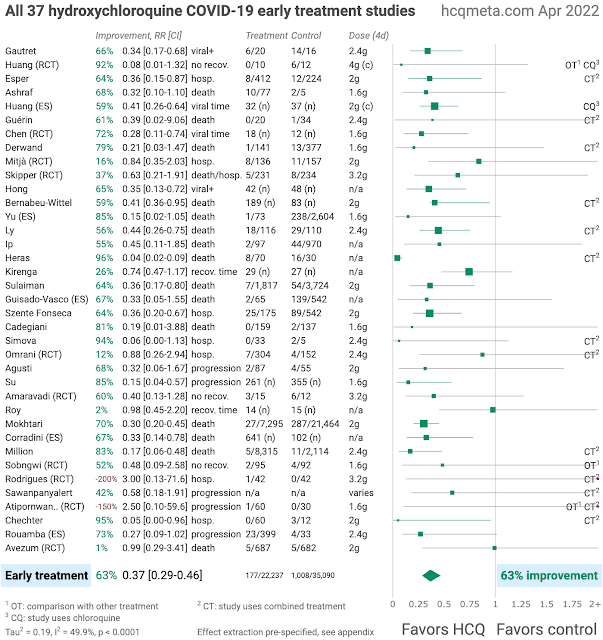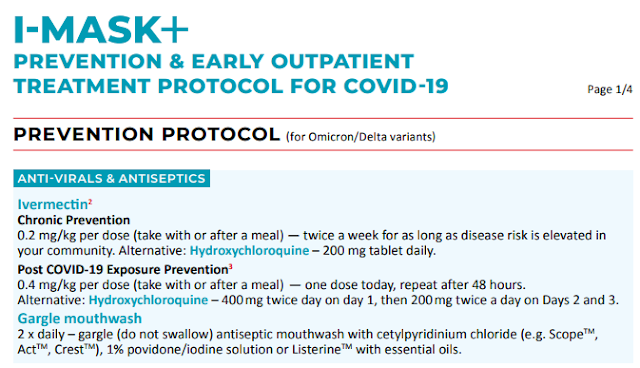Natural Alternatives to Hydroxychloroquine (April 2022)
Hydroxychloroquine, a less toxic derivative of Chloroquine is a widely used medication by people with lupus or arthritis. It was first approved in the 1950s.
As of April 2022, there have been more than 30 studies of Hydroxychloroquine for early treatment – all with zero negative results for the most serious outcome reported. The average risk reduction for the most serious outcome reported in these trials was 63%. (c19hcq.com)
Here’s a chart from c19early.com that shows that hydroxychloroquine performs better than ivermectin when given as early treatment in terms of risk reduction of dying from COVID-19:
The overall improvement for hydroxychloroquine is better than ivermectin (for early treatment); 74 % vs 44 % in terms of death rate. Importantly, hydroxychloroquine needs to be given 'early'.
The latest FLCCC I-MASK protocol has also incorporated hydroxychloroquine as part of the prevention and treatment protocols:
The difference in terms of effectiveness for hydroxychloroquine is distinctly different when given early vs late treatment (75% vs 19%), as shown in the summary chart below:
The evidence tracking on Hydroxychloroquine versus COVID-19 is available at c19hcq.com (constantly updated).
Here’s a chart from c19early.com that shows that hydroxychloroquine performs better than ivermectin when given as early treatment in terms of risk reduction of dying from COVID-19:
The overall improvement for hydroxychloroquine is better than ivermectin (for early treatment); 74 % vs 44 % in terms of death rate. Importantly, hydroxychloroquine needs to be given 'early'.
The latest FLCCC I-MASK protocol has also incorporated hydroxychloroquine as part of the prevention and treatment protocols:
The difference in terms of effectiveness for hydroxychloroquine is distinctly different when given early vs late treatment (75% vs 19%), as shown in the summary chart below:
The evidence tracking on Hydroxychloroquine versus COVID-19 is available at c19hcq.com (constantly updated).
Natural Alternatives to Hydroxychloroquine
If hydroxychloroquine could stop the virus, was this because the medications act as zinc ionophores? If so, its begs the question, “Do other zinc ionophores do the same thing?”1. Quercetin
Dietary SourcesQuercetins are naturally occurring flavonoids. These flavonoids are found in a variety of foods, including vegetables such as onions, garlic, brassica, mustard greens, and ginger; fruit such as apples, berries, and grapes; and many seeds, nuts, flowers bark and tea leaves.
Quercetin as a Zinc Ionophore
Quercetin is a zinc ionophore (J Agric Food Chem. 2014). A 2015 study found that that Quercetin shows inhibitory activity in the early stages of a wide range of influenza viruses, including H1N1 and H5N1 (Viruses 2016). Although influenza is not in the same family of viruses as the coronavirus, it’s plausible that a similar mechanism could apply here. There is actually some evidence that Quercetin has already proven effective at treating Ebola and Zika viruses.
Quercetin Dosage
The FLCCC I-MASK+ protocol recommends 250 mg daily for prevention and 250 mg twice daily for early treatment.
Quercetin works best when taken with vitamin C and Bromelain, as vitamin C helps activate it and bromelain helps with the absorption.
 |
| Effect of QCT, EGCG, and CQ on the uptake of zinc cations by liposomes. Zinc-dependent fluorescence emission of FluoZin-3 encapsulated within liposomes treated with zinc cations, polyphenols, and CQ (J Agric Food Chem. 2014). |
2. Epigallocatechin 3-Gallate (EGCG)
EGCG is a catechin found primarily in green tea and touted as the most effective chemopreventive polyphenol (19). A study (J Agric Food Chem. 2014) found EGCG amplified the effectiveness of Quercetin as a zinc ionophore. This suggests that ECGC and Quercetin provide a synergistic effect with enhanced bioavailability.
A new in-vitro study posted to BioRxiv (June 21, 2021), provided evidence of the potential of green tea catechin against COVID-19 virus.
EGCG Dosage
The Zelenko protocol recommends 400 mg once a day for prevention and 400 mg twice daily for early treatment taken together with zinc.
3. Zinc
This trace element is essential to to cell function and involved in over 100 enzymes. Zinc has long been tauted for it’s potential to support the immune system, but also plays an important role in wound healing, fertility, preventing and treating pneumonia and preserving community between neurons (memory).The National Institutes of Health (NIH) states:“Zinc is involved in numerous aspects of cellular metabolism. It is required for the catalytic activity of approximately 100 enzymes and it plays a role in immune function, protein synthesis, wound healing, DNA synthesis, and cell division. Zinc also supports normal growth and development during pregnancy, childhood, and adolescence and is required for proper sense of taste and smell.”
Zinc Form and Dosage
There are several types of zinc supplements. Supplements contain several forms of zinc, including zinc gluconate, zinc citrate and zinc picolinate. The percentage of elemental zinc varies by form. To find out the percentage of elemental zinc in each form, check out elemental zinc percentage.
Chelated zinc is a general form of supplementary zinc in which the zinc is chelated — or bound — to a compound to make it easier for the body to absorb. Zinc picolinate or zinc gluconate are formed when zinc is chelated to picolinic acid or gluconic acid, so the main difference between zinc gluconate and picolinate is what compound it is bound to.There are several types of zinc supplements. Supplements contain several forms of zinc, including zinc gluconate, zinc citrate and zinc picolinate. The percentage of elemental zinc varies by form. To find out the percentage of elemental zinc in each form, check out elemental zinc percentage.
To find out which zinc supplement to consider, check out best zinc supplement 2021.
Most people do not lack an intake of zinc, but in disease state, there might be an increase in demand by the body. The FLCCC I-MASK+ protocol recommends 30 mg a day for prevention and 100 mg a day for early treatment of COVID-19. This should not be taken long term without evaluation of your zinc/copper ratios.
Where Can I Buy These Products?
Summary
The combination of quercetin, EGCG and zinc offer a high virus inhibiting potential with a valuable degree of safety at a time of great uncertainty. Quercetin, EGCG and zinc are also part of the FLCCC protocol and Zelenko protocol.
That said, they are not 'magic bullets' and you still need to follow other precautions (as advised by your local health authorities and doctors) in order to minimise your risk.
Related:








.png)


Comments
Post a Comment